Backing up a travel trailer can seem daunting, but with the right techniques and a little practice, you can master it. TRAVELS.EDU.VN is here to provide a comprehensive guide on how to confidently and safely maneuver your RV into any campsite. Learn essential tips, tricks, and step-by-step instructions to enhance your RVing experience. Perfecting your parking prowess is crucial for a smooth and stress-free camping experience.
1. Understanding the Basics of Travel Trailer Backing
Before diving into the step-by-step process, it’s crucial to understand the fundamental principles of backing up a travel trailer. This involves grasping the physics of trailer movement, understanding how your tow vehicle interacts with the trailer, and knowing your equipment’s limitations.
1.1. The Physics of Trailer Movement
The key to understanding How To Back Up A Travel Trailer is grasping the concept of opposite steering. When you turn the steering wheel to the right, the trailer moves to the left, and vice versa. This counterintuitive motion is due to the pivot point at the hitch. Understanding this principle is crucial for making precise adjustments.
1.2. Knowing Your Tow Vehicle and Trailer
Each tow vehicle and trailer combination handles differently. Factors like wheelbase, trailer length, and hitch type (e.g., weight distribution hitch) affect maneuverability. Familiarize yourself with your setup by practicing in a large, open area before heading to a campground.
1.3. Essential Equipment for Backing Up
- Mirrors: Extended side mirrors are a must-have for visibility.
- Walkie-Talkies/Cell Phones: For communication with a spotter.
- Wheel Chocks: To secure the trailer once it’s in position.
- Leveling Blocks: To ensure the trailer is level once parked.
2. The 6-Step Process to Backing Up Your Travel Trailer Solo
Backing up a travel trailer solo can seem challenging, but by following a structured approach, you can minimize stress and maximize accuracy. Here’s a six-step process to guide you:
2.1. Step 1: Site Survey – Assess and Plan
Before attempting to back into a campsite, conduct a thorough site survey. This involves assessing the campsite’s layout, identifying potential obstacles, and planning your approach.
-
Pull Up and Park: Position your tow vehicle in front of the campsite, ensuring you don’t block the campground road.
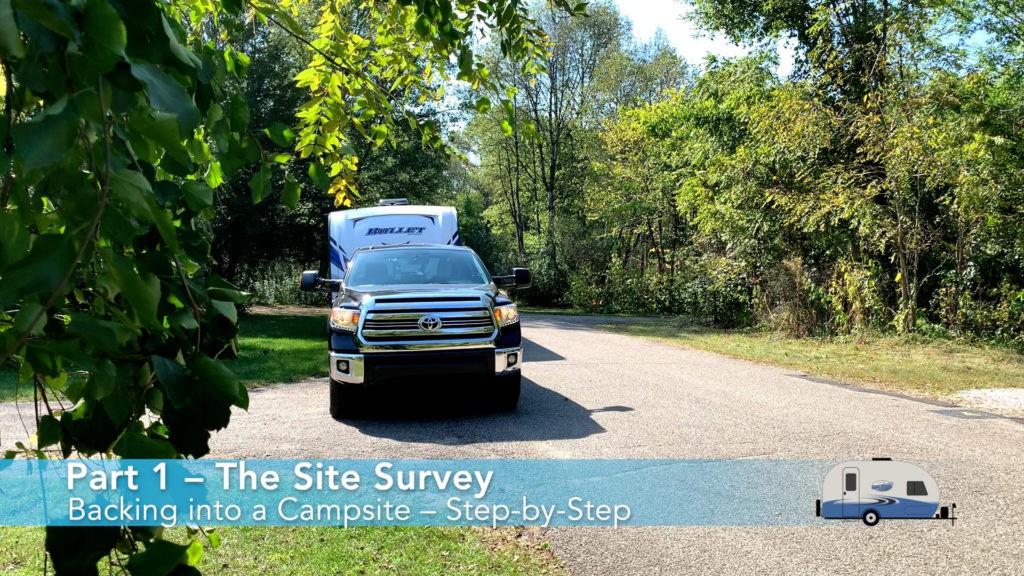 Parked Truck and RV for Site Survey
Parked Truck and RV for Site Survey -
Identify Obstacles: Look for trees, rocks, utility poles, and other potential hazards. Note the location of utility hookups (electrical, water, sewer).
-
Assess the Terrain: Check for uneven ground or slopes that might affect your leveling process.
-
Visualize the Final Position: Determine where you want the RV to sit on the campsite, considering slide-out clearance and access to utilities. According to the National Park Service, campsites are often designed to minimize environmental impact, so understanding the site’s boundaries is crucial.
-
Mark Reference Points: Use cones, wheel chocks, or levelers to mark the front and back corners of your desired RV position. This will provide visual cues during the backing process.
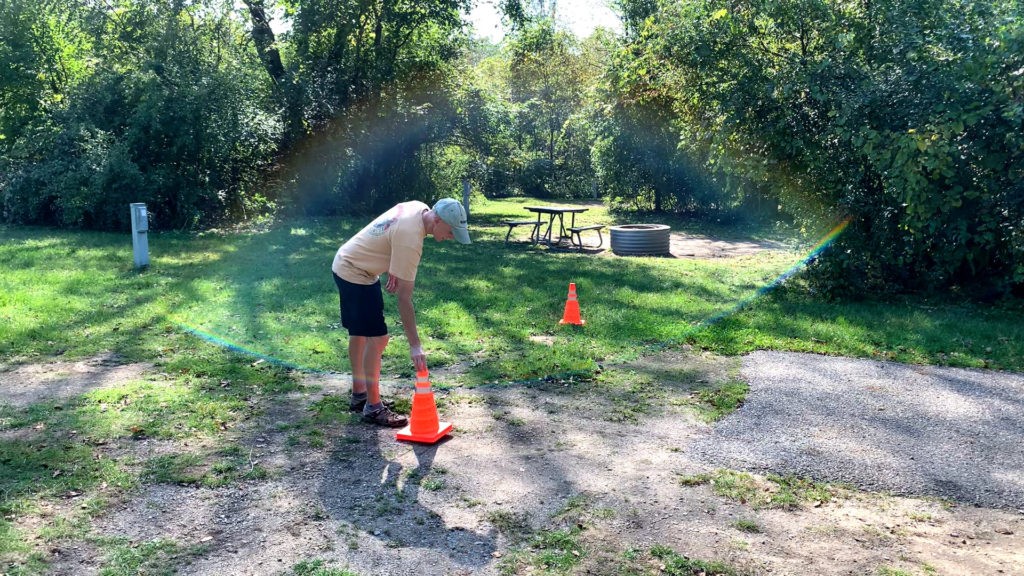 Orange Cones Marking RV Position
Orange Cones Marking RV Position -
Pro Tip: Consider using a campsite booking website with detailed photos and satellite views to preview the site before arrival. Many sites, like those found on ReserveAmerica, offer this feature.
2.2. Step 2: Starting Position – Setting Yourself Up for Success
The starting position is crucial for a smooth back-in. Position your tow vehicle and trailer in a way that allows for a controlled and accurate maneuver.
-
Pull Past the Campsite: Drive past the campsite entrance, positioning the rear corner of the trailer parallel to the front corner of the campsite. This provides ample room for your initial turn.
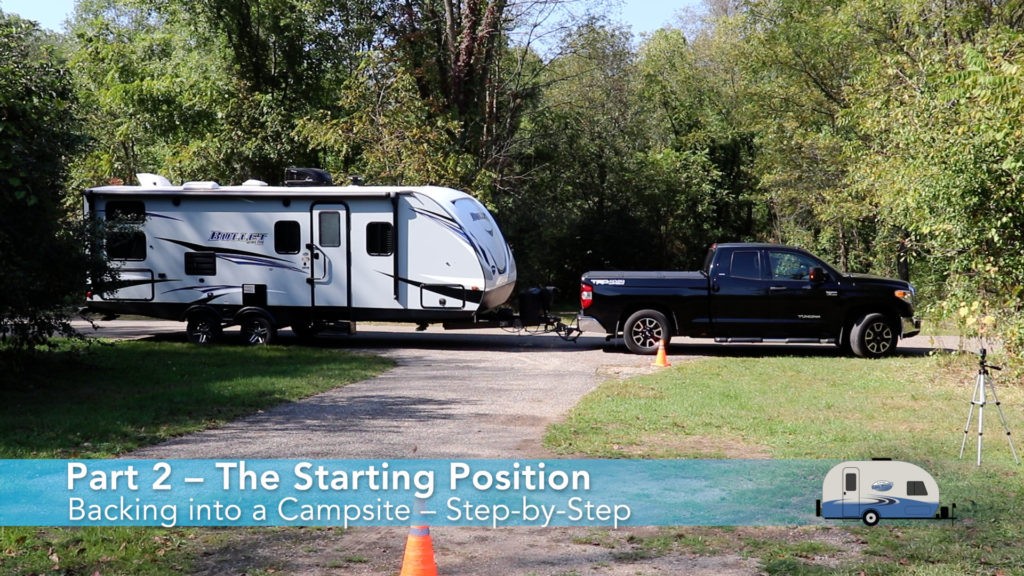 Truck and Trailer in Starting Position
Truck and Trailer in Starting Position -
Check Your Mirrors: Ensure your mirrors are properly adjusted to provide a clear view of the campsite and surrounding area.
-
Communicate: If you have a spotter, establish clear hand signals or use walkie-talkies for communication.
2.3. Step 3: Cut-Back Turn – Initiating the Maneuver
The cut-back turn is where you initiate the backing process, angling the trailer toward the campsite.
-
Steer in the Opposite Direction: Turn the steering wheel in the opposite direction you want the trailer to go. For example, if you want the trailer to move to the left, turn the steering wheel to the right.
-
Move Slowly and Deliberately: Back up slowly, making small adjustments to the steering wheel as needed.
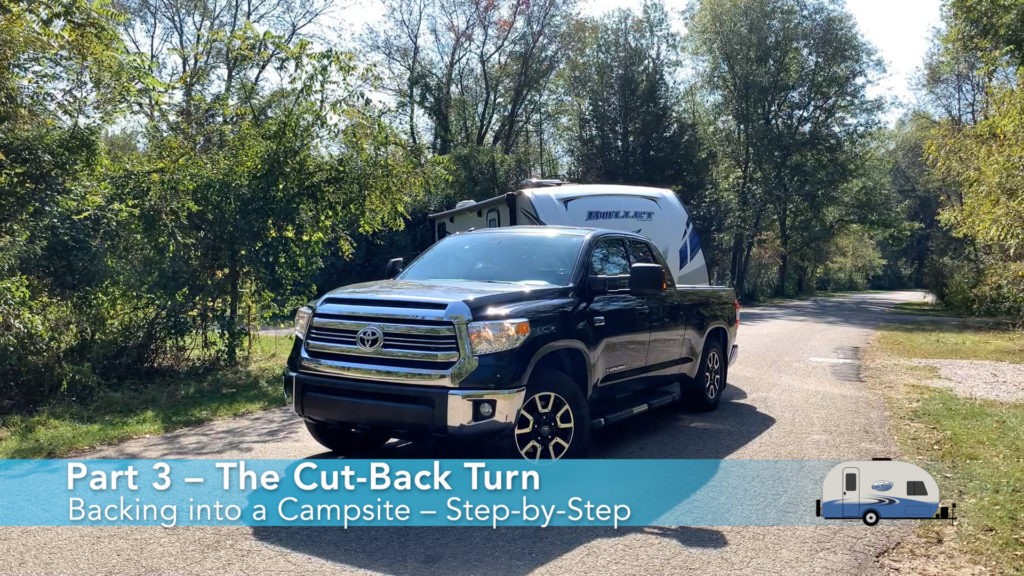 Cut-Back Turn Maneuver
Cut-Back Turn Maneuver -
Use Your Mirrors: Constantly monitor the trailer’s position using your mirrors, paying close attention to obstacles and reference points.
-
Pivot Around the Cone: Visualize the trailer pivoting around the front corner cone as you cut into the campsite.
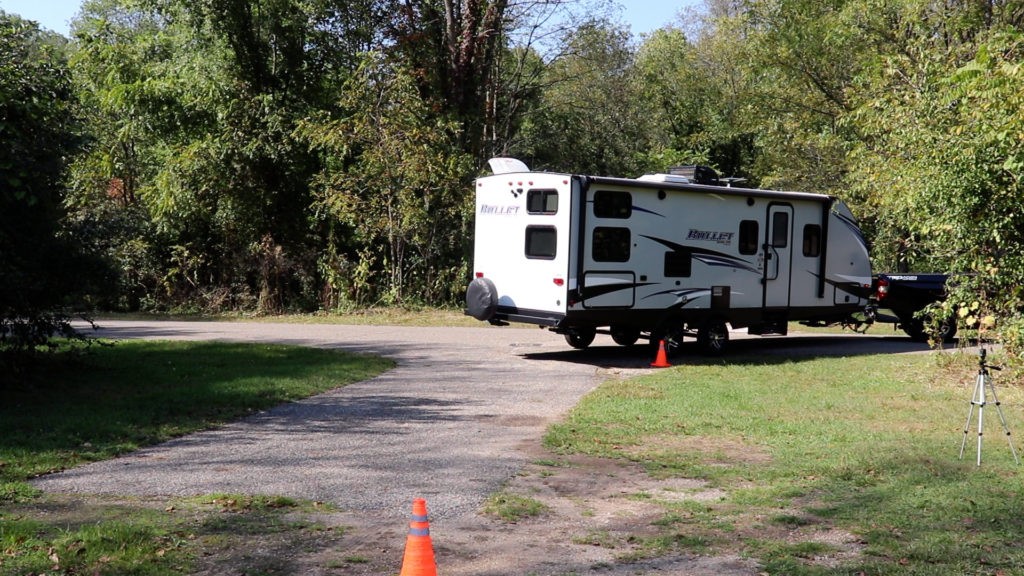 Rear View of Trailer Pivoting
Rear View of Trailer Pivoting -
Pro Tip: If you’re unsure, stop and reassess. It’s better to take your time and make adjustments than to risk damaging your RV or tow vehicle.
2.4. Step 4: Unwind and Follow – Straightening Out
Once you’ve initiated the cut-back turn, you’ll need to unwind the steering wheel and follow the trailer into the campsite.
-
Unwind the Turn: As the trailer begins to move in the desired direction, gradually unwind the steering wheel to straighten out the tow vehicle.
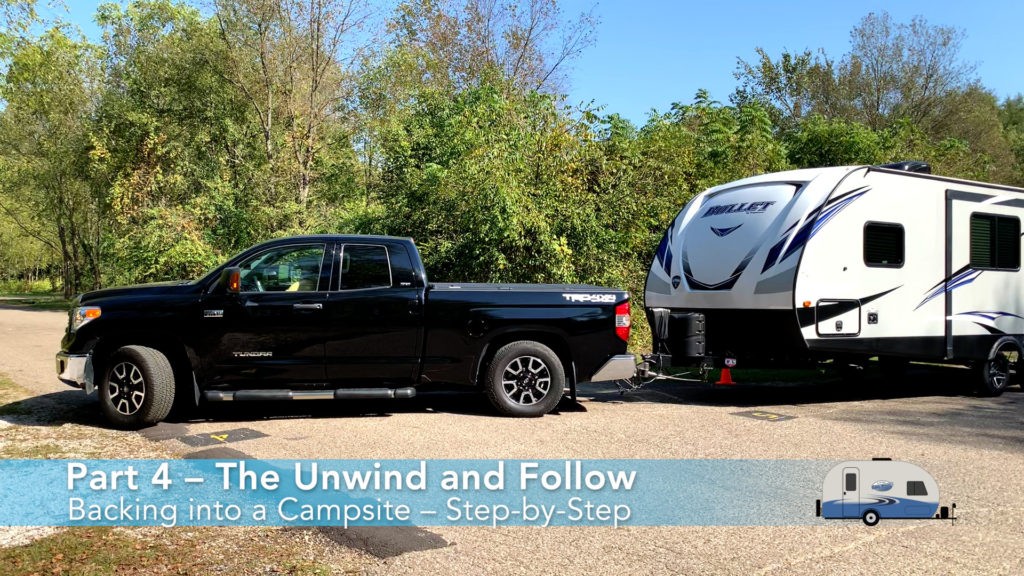 Unwinding the Trailer Turn
Unwinding the Trailer Turn -
Monitor the Tow Vehicle: Pay close attention to the front of your tow vehicle, ensuring it doesn’t swing too wide and hit any obstacles.
-
Adjust as Needed: Make small adjustments to the steering wheel to keep the trailer aligned with your desired path.
-
Overshooting or Undershooting: If you overshoot or undershoot your target, don’t worry. You can adjust in the next step.
2.5. Step 5: Pull Forward – Correcting Your Position
The pull-forward step allows you to correct any misalignments and set yourself up for a straight back-in.
-
Pull Straight Out: Pull forward as much as possible, straightening out the tow vehicle and trailer.
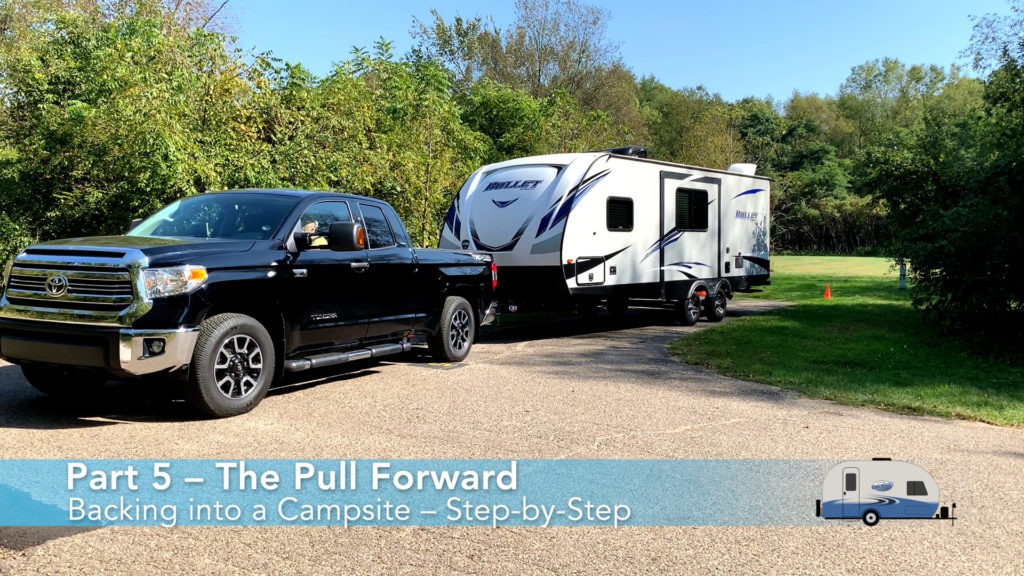 Pulling Forward to Correct Position
Pulling Forward to Correct Position -
Assess Your Position: Take a moment to reassess your position and plan your final back-in.
-
Consider a Do-Over: If the situation is too challenging, don’t hesitate to pull out completely and go around the loop for another attempt.
-
Pro Tip: Use this opportunity to communicate with your spotter and refine your plan.
2.6. Step 6: Push Back to Marks – Final Positioning
The final step involves backing the trailer into its designated spot, aligning it with your reference points.
-
Back Straight In: Back in slowly and deliberately, using your reference cones as guides.
-
Align with Cone Marks: Aim to align the back corners of the RV with the cone marks you placed during the site survey.
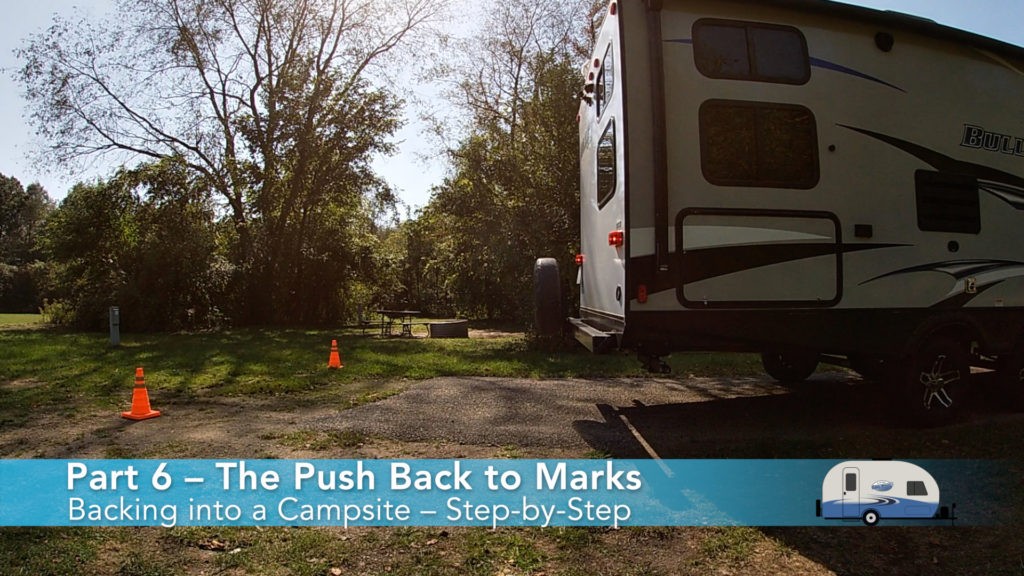 Final Push Back to Marks
Final Push Back to Marks -
Check Utility Hookups: Ensure you have adequate room for slide-outs and easy access to utility connections (electrical, water, sewer).
-
Final Adjustments: Make any necessary minor adjustments to ensure the trailer is perfectly positioned.
3. Essential Tips and Tricks for Successful Travel Trailer Backing
Mastering the art of backing up a travel trailer involves more than just following a step-by-step process. Here are some essential tips and tricks to enhance your skills:
3.1. Practice Makes Perfect
The most effective way to improve your backing skills is to practice regularly. Find a large, open parking lot or empty field and practice maneuvering your travel trailer in different scenarios. As stated by the RV Safety & Education Foundation, “Practice in a controlled environment is the best way to build confidence and skills.”
3.2. Slow and Steady Wins the Race
Backing up a travel trailer is not a race. Take your time, move slowly, and make small adjustments to the steering wheel. Rushing can lead to mistakes and potential damage.
3.3. Use a Spotter for Enhanced Safety
A spotter can provide valuable assistance by guiding you and alerting you to potential hazards. Ensure your spotter is positioned in a safe location and has a clear view of the campsite. Use clear and concise hand signals for communication.
3.4. Adjust Your Mirrors for Optimal Visibility
Properly adjusted mirrors are crucial for visibility. Adjust your side mirrors to provide a clear view of the trailer’s sides and rear. Consider using convex mirrors to expand your field of vision.
3.5. Be Aware of Your Surroundings
Pay close attention to your surroundings, including trees, rocks, utility poles, and other obstacles. Be mindful of low-hanging branches that could damage your RV’s roof.
3.6. Use Technology to Your Advantage
Several technologies can assist with backing up a travel trailer, including backup cameras and parking sensors. These tools can provide valuable visual and auditory cues, making the process easier and safer.
3.7. Choose Your Campsites Wisely
When booking campsites, consider the ease of access and the layout of the site. Pull-through sites are the easiest to navigate, while back-in sites can be more challenging. Look for sites with wide entrances and minimal obstacles.
3.8. Communicate with Fellow Campers
If you’re having difficulty backing into a campsite, don’t hesitate to ask for help from fellow campers. Most RVers are happy to lend a hand and offer advice.
3.9. Maintain Your Equipment
Ensure your tow vehicle and travel trailer are properly maintained. Check your tires, brakes, and lights regularly. A well-maintained rig is essential for safe and confident maneuvering.
4. Common Mistakes to Avoid When Backing Up a Travel Trailer
Even with proper training and preparation, mistakes can happen. Here are some common errors to avoid:
4.1. Oversteering
Oversteering is a common mistake that can cause the trailer to swing wildly. Make small, controlled adjustments to the steering wheel, and avoid jerky movements.
4.2. Rushing the Process
Rushing can lead to mistakes and potential damage. Take your time, move slowly, and focus on accuracy.
4.3. Not Using a Spotter
A spotter can provide valuable assistance and prevent accidents. Don’t attempt to back into a campsite without a spotter, especially in challenging situations.
4.4. Ignoring Your Surroundings
Failing to pay attention to your surroundings can lead to collisions with trees, rocks, and other obstacles. Be vigilant and aware of your surroundings at all times.
4.5. Neglecting Mirror Adjustments
Improperly adjusted mirrors can limit your visibility and make it difficult to maneuver the trailer. Take the time to adjust your mirrors properly before attempting to back in.
4.6. Assuming All Campsites Are the Same
Each campsite is unique, with its own challenges and obstacles. Don’t assume that a technique that worked on one site will work on another. Always conduct a site survey and adapt your approach accordingly.
5. Why You Should Book Your Napa Valley RV Trip with TRAVELS.EDU.VN
Planning an RV trip to Napa Valley? TRAVELS.EDU.VN offers unparalleled expertise and personalized service to ensure your journey is unforgettable. Here’s why you should choose us for your Napa Valley RV adventure:
5.1. Expertly Curated RV-Friendly Campsites
We handpick RV-friendly campsites in Napa Valley that offer the perfect blend of convenience, amenities, and natural beauty. Whether you prefer a secluded spot amidst the vineyards or a full-service campground with all the bells and whistles, we have options to suit your preferences.
5.2. Personalized Trip Planning Assistance
Our team of experienced travel advisors will work with you to create a custom itinerary that aligns with your interests and budget. From winery tours and gourmet dining to outdoor adventures and scenic drives, we’ll help you make the most of your Napa Valley RV experience.
5.3. Exclusive Access to Napa Valley Experiences
Through our extensive network of partners, we provide exclusive access to unique Napa Valley experiences that you won’t find anywhere else. Enjoy private wine tastings, behind-the-scenes tours of renowned wineries, and VIP access to local events.
5.4. Stress-Free Booking and Support
We handle all the details of your RV trip, from campsite reservations and activity bookings to transportation arrangements and travel insurance. Our dedicated support team is available 24/7 to assist you with any questions or concerns that may arise.
5.5. Competitive Pricing and Value
We offer competitive pricing on all our Napa Valley RV packages, without compromising on quality or service. We believe that everyone deserves a memorable travel experience, regardless of their budget.
5.6. Seamless RV Rental Services
Don’t own an RV? No problem. TRAVELS.EDU.VN partners with leading RV rental companies to provide you with a wide selection of well-maintained and fully equipped RVs. We’ll help you find the perfect RV for your Napa Valley adventure, ensuring a comfortable and hassle-free journey.
5.7. Local Expertise and Insider Knowledge
Our team of Napa Valley experts has in-depth knowledge of the region, including its hidden gems, local favorites, and best-kept secrets. We’ll share our insider knowledge with you, helping you discover the authentic Napa Valley experience.
5.8. Commitment to Sustainable Tourism
TRAVELS.EDU.VN is committed to promoting sustainable tourism practices in Napa Valley. We partner with local businesses that prioritize environmental stewardship and community engagement, ensuring that your RV trip benefits the region and its residents.
5.9. Convenient Location and Contact Information
Visit our office at 123 Main St, Napa, CA 94559, United States, or contact us via WhatsApp at +1 (707) 257-5400. You can also explore our website at TRAVELS.EDU.VN for more information and booking options.
5.10. Book Your Unforgettable Napa Valley RV Trip Today
Don’t wait any longer to experience the magic of Napa Valley in an RV. Contact TRAVELS.EDU.VN today to start planning your dream getaway. Let us handle the details while you focus on creating memories that will last a lifetime.
6. Napa Valley RV Trip Planning: Addressing Your Concerns
Planning an RV trip, especially to a renowned destination like Napa Valley, can bring about several concerns. TRAVELS.EDU.VN understands these challenges and offers solutions to ensure a smooth and enjoyable experience.
6.1. Overcoming the Challenges of RV Trip Planning
Many travelers find it difficult to find and select RV-friendly campsites that align with their preferences and budget. The process of planning a detailed itinerary can be time-consuming, and concerns about service quality and reliability of travel providers are common. Additionally, travelers seek unique and memorable experiences and updated, useful information about the destination.
6.2. How TRAVELS.EDU.VN Streamlines Your Napa Valley RV Planning
TRAVELS.EDU.VN addresses these concerns by providing services that save time and effort, offering diverse, high-quality RV packages tailored to various needs, ensuring seamless and memorable experiences, providing detailed information about Napa Valley, and offering support throughout the booking process and during your trip.
6.3. Comprehensive Services to Enhance Your Trip
- Expert Trip Planning: We handle all the details, from campsite reservations to activity bookings.
- Diverse RV Packages: Tailored to different interests and budgets.
- Guaranteed Quality: We partner with reputable service providers to ensure a high standard of quality.
- Unique Experiences: Access to exclusive tours, tastings, and events.
- 24/7 Support: Our team is available to assist you with any questions or concerns.
6.4. Get Expert Advice – Contact Us Today
Are you ready to experience the best of Napa Valley in an RV? Contact TRAVELS.EDU.VN today for a consultation on our custom RV travel packages.
Call to Action:
For personalized assistance and expert guidance in planning your Napa Valley RV trip, contact TRAVELS.EDU.VN now via WhatsApp at +1 (707) 257-5400 or visit our office at 123 Main St, Napa, CA 94559, United States. Let us turn your travel dreams into reality.
7. Troubleshooting Common Travel Trailer Backing Scenarios
Even with careful planning and practice, you may encounter challenging scenarios while backing up your travel trailer. Here’s how to troubleshoot some common situations:
7.1. Narrow Campground Roads
Narrow roads make it difficult to maneuver, especially when unwinding the initial turn.
- Solution: Take it slow and use a spotter to guide you. Consider pulling forward multiple times to adjust your angle.
7.2. Perpendicular Campsite Entrances
These sites require a sharper initial turn, increasing the risk of hitting the tow vehicle.
- Solution: Practice the cut-back turn in an open area before arriving at the campground. Use cones to simulate the campsite entrance.
7.3. Obstacles and Tight Spaces
Trees, rocks, and utility poles can make backing up a challenge.
- Solution: Conduct a thorough site survey and identify all obstacles. Use a spotter to guide you and avoid potential hazards.
7.4. Uneven Terrain
Uneven ground can make it difficult to level the trailer and can affect your backing maneuver.
- Solution: Use leveling blocks to compensate for uneven terrain. Consider using an RV leveling app to ensure your trailer is level.
7.5. Poor Visibility
Limited visibility can make it difficult to see obstacles and judge distances.
- Solution: Use extended mirrors and a backup camera to improve visibility. If necessary, ask a fellow camper to act as a spotter.
8. Understanding Campground Etiquette While Backing Up
Backing up a travel trailer requires not only skill but also awareness of campground etiquette. Here are some guidelines to follow:
8.1. Be Considerate of Other Campers
Avoid blocking campground roads for extended periods. If you’re having difficulty backing in, pull forward and allow other campers to pass.
8.2. Keep Noise to a Minimum
Avoid excessive noise, especially early in the morning or late at night. Turn off your engine when you’re not actively maneuvering the trailer.
8.3. Respect Campsite Boundaries
Be mindful of campsite boundaries and avoid encroaching on neighboring sites.
8.4. Clean Up After Yourself
Leave the campsite cleaner than you found it. Dispose of trash properly and avoid leaving any debris behind.
8.5. Be Patient and Courteous
Backing up a travel trailer can be stressful, but it’s important to remain patient and courteous. Treat fellow campers with respect and offer assistance if they need it.
9. Essential RV Maintenance Tips for Safe Backing
Maintaining your RV is essential for safe backing and overall travel. Here are some maintenance tips to keep in mind:
9.1. Tire Maintenance
Check your tire pressure regularly and ensure your tires are in good condition. Replace worn or damaged tires promptly.
9.2. Brake Inspection
Inspect your brakes regularly and ensure they are functioning properly. Replace worn brake pads or shoes as needed.
9.3. Lighting System
Check your RV’s lighting system regularly and ensure all lights are working properly. Replace burned-out bulbs promptly.
9.4. Hitch Maintenance
Inspect your hitch regularly and ensure it is securely attached to the tow vehicle. Lubricate the hitch ball as needed.
9.5. Suspension System
Inspect your RV’s suspension system regularly and ensure all components are in good condition. Replace worn or damaged components as needed.
10. FAQs About Backing Up a Travel Trailer
Here are some frequently asked questions about backing up a travel trailer:
- What is the most common mistake people make when backing up a travel trailer? Oversteering is a frequent error, causing the trailer to swing excessively.
- How can I improve my visibility while backing up? Use extended mirrors and a backup camera for enhanced visibility.
- What should I do if I’m having trouble backing into a campsite? Pull forward and reassess the situation. If necessary, ask for assistance from a fellow camper.
- Is it better to back in on the driver’s side or passenger side? Backing in on the driver’s side is generally easier due to better visibility.
- What is the best way to communicate with a spotter? Use clear and concise hand signals for effective communication.
- How can I prevent damage to my RV while backing up? Conduct a thorough site survey and be aware of your surroundings.
- What should I do if I hit an obstacle while backing up? Stop immediately and assess the damage. If necessary, file a report with the campground management.
- How often should I practice backing up my travel trailer? Practice regularly to improve your skills and build confidence.
- What are some essential tools for backing up a travel trailer? Extended mirrors, wheel chocks, and leveling blocks are essential tools.
- Should I use a weight distribution hitch when towing a travel trailer? A weight distribution hitch can improve stability and handling, especially when towing a larger trailer.
Mastering the art of backing up a travel trailer takes time and practice, but with the right techniques and a little patience, you can become a confident and skilled RVer. TRAVELS.EDU.VN is here to support you on your journey, providing expert advice, personalized service, and unforgettable travel experiences. Visit travels.edu.vn today to start planning your dream RV adventure.
